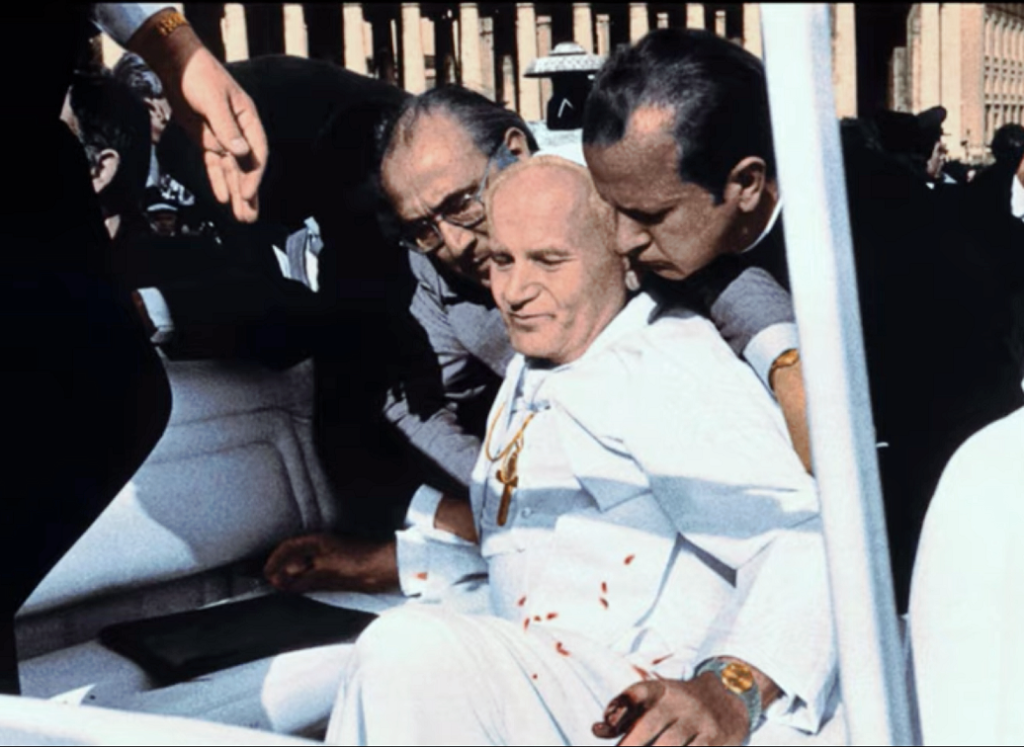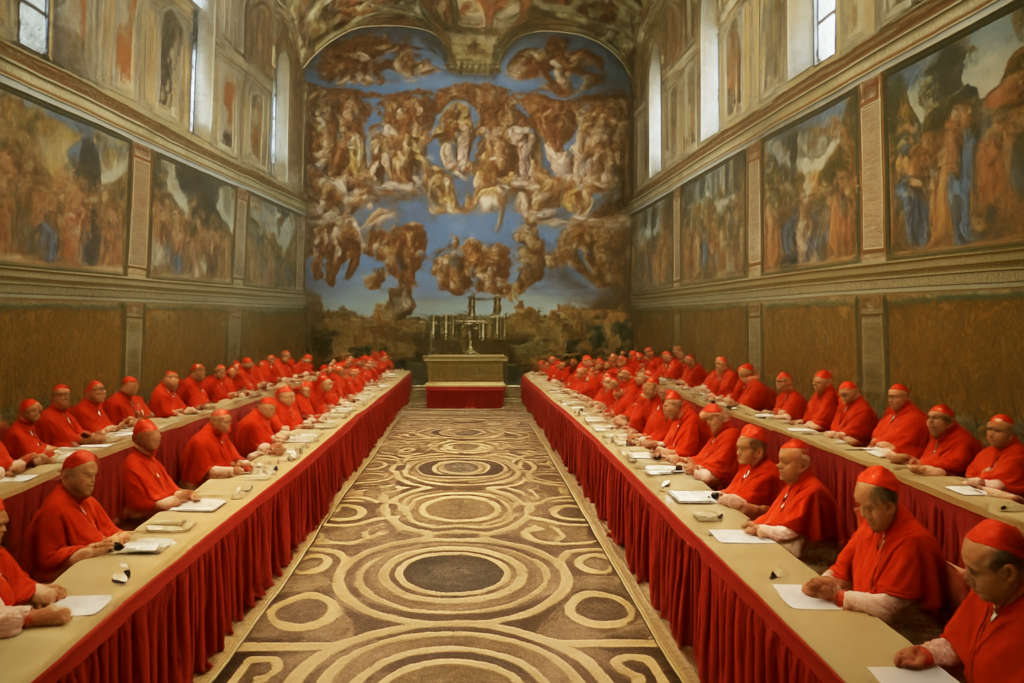The Motherly Hand Which Saved John Paul II
40 Years Ago the Attack on Polish Pontiff in St. Peter's Square

During the 27 unforgettable years of his pontificate, John Paul II broke countless records, in terms of numbers of trips, audiences, meetings and so on. However, there is another record that St. Pope John Paul II, if he could, perhaps would have spared himself: fifteen aggressions he suffered many still today unknown to faithful and journalists.
The most serious and famous remains the attack on May 13, 1981 in Saint Peter’s Square, during the tour in the square to greet the crowds, on the popemobile, before the General Audience. At 5:17 pm, 23-yer-old Turk Ali Agca, lurking in the crowd, fired two pistol shots at the Pope, from a distance of merely 3 or 4 meters. One of the bullets seriously wounded John Paul II’s abdomen, causing him very serious lesions to the intestine.
The wounded and bleeding Pope was taken by ambulance to Rome’s Gemelli Hospital in a race against time. His vital functions were failing minute by minute. In the hospital’s operating room, his personal secretary Stanislaw Dziwisz, future Archbishop of Krakow, taking the advice of the doctors, administered–weeping–last rites to the ailing Pontiff.
Gemelli’s surgeons discovered shortly after with relief that the Ali Agca’s bullet, although having severely damaged several organs, had missed the aorta by a few millimeters. Had it been otherwise, the Pope would have died in a few minutes. Just after midnight, the whole world learned from the bulletin issued by Gemelli the greatly awaited news: the Pope was saved!
Meanwhile, the attacker was arrested immediately by the police, with the help of two sisters: one remains unknown, namely the nun who grabbed Ali Agca’s arm, impeding him from firing further shots. The other was Franciscan Sister Letizia Giudici, whose intervention was decisive in impeding Agca from making his way through the crowd and fleeing. A portrait of Ali Agca is still difficult to depict today. He certainly was an expert killer, who himself was surprised that he didn’t succeed in killing the Pope (but he once said that this was not his intention), that he had not acted alone but with the support of principals and supporters, of whom nothing clear is known, even today, 40 years later. And his collaboration in unravelling the often incoherent confusion of the investigations reveals itself always contradictory and, hence, useless. Although not yet knowing his name, already in the ambulance to the Gemelli, Pope John Paul II had words of forgiveness for him. And, in fact, on December 27, 1983, the Pope visited him in Rome’s Rebibbia prison, for an intense 10-minute, face-to-face conversation of which the Pope reported almost nothing to others.
The danger of death averted, the doctors’ x-rays revealed that the bullet entered the Pope’s body near the navel and exited from the back. It hadn’t followed a linear trajectory, dodging all the vital organs. It was thus that meditating on what happened, in the days of recovery at Gemelli, John Paul II soon matured the conviction that “a hand separated and deflected the trajectory And the hand that saved him couldn’t but be but that of the Virgin of Fatima, celebrated on that day, May 13, the date of the first of the six apparitions — in the now distant 1917 — to Francisco, Jacinta and Lucia, three little shepherds of the locality of Portugal, which then became one of the world’s most frequented Marian shrines.
The care of the wounded and weakened Pope required more time than foreseen, until June 3, when Karol Wojtyla left the hospital. However, soon a second recovery was necessary, much longer than the first, until August 14, to care for the Cytomegalovirus infection contracted during the desperate operation a few hours after the attack.
Thus it was that, at the beginning of August 1981, reflecting on the facts of May 13, the Polish Pope asked his Secretary, Father Stanislaw, to read him the text of the third secret of Fatima, written in 1944 by Lucia, the only visionary of the three still alive, and read until that moment only by his Predecessors, Popes John XXIII and Paul VI.
A year later, on May 13, 1982, John Paul II flew to Portugal to be a pilgrim in Fatima to thank Our Lady in person, who the year before saved his life. Few remember that the day before, on the evening of May 12, a Spanish priest, Juan Maria Fernandez y Krohn , opponent of the reforms of Vatican Council II, also tried to attack the Pope with a knife, even managing to reach John Paul II’s side with the blade. However that time the wound, which was quite light, didn’t require immediate care. Instead, the journalists present still remember well the Pope’s intense prayer in silence, live on TV, in front of the Virgin’s statue.
That same statue was then taken to Rome in 1984, by Pope John Paul II’s wish, to celebrate a solemn “act of consecration of the world” to the Immaculate Heart of Mary, as the Virgin requested at Fatima in the second part of the secret. In the meantime, the bullet that almost killed the Pontiff in 1981 was sent to the Portuguese Bishop of Leiria-Fatima, who had it embedded in the statue’s crown, where it is still found today.
The travelling Pope went to the shrine again in ’91 and then in 2000 during the Jubilee. And that third trip of the pontificate to Fatima was the densest in meanings and suggestions. In 1981, during the first recovery at Gemelli, the Pope received from Poland the sad news of the death of Polish Cardinal Stefan Wyszynski, Archbishop of Warsaw and Primate of Poland, dear friend of Karol Wojtyla, to whom he prophesized in the conclave that elected Pope John Paul II: “You will introduce the Church in the third millennium.” Words that no doubt returned often to the Pope’s mind, in that dramatic 1981 and then also when celebrating the Solemn Jubilee of 2000.
On May 13, 2000 in Fatima, John Paul II did more than just beatify the little shepherds Jacinta and Francisco, who died at a tender age shortly after the apparitions at Fatima. The trip to Portugal was also the occasion to have the Secretary of State Cardinal Sodano announce, on the esplanade of the Shrine, that John Paul II had decided to make public the third part of the secret of Fatima, read by him 19 year earlier, and on which in the course of the decades surreal and apocalyptic readings had multiplied. The publication took place on June 26, 2000 in the Holy See Press Office, crowded with journalists from all over the world.
“The vision of Fatima,” anticipated Cardinal Sodano, “has to do especially with the fight of atheist systems against the Church and Christians and describes the terrible suffering of the witnesses of the faith of the last century of the second millennium. It is an endless Via Crucis led by Popes of the 20th Century.”
And that third part of the secret, which contains the famous vision of the “bishop dressed in white” who, walking among ruins and corpses, arrives at the top of a hill surmounted by a cross, and falls dead here, pierced by arrows and firearms, together with many other bishops, priests, religious, and men and women who were with him. This vision, commented again the then Prefect of the Congregation for the Doctrine of the Faith Cardinal Ratzinger, future Pope Benedict XVI, recalls the Church’s martyrdom in the 20th Century, the century of world wars, of totalitarianisms, of ethnic cleansings, of persecutions. In that writing, Pope John Paul II saw suddenly the sign of the special protection received from God, through the intercession of Our Lady of Fatima, when he himself risked death. “It was a maternal hand that guided the trajectory of the bullet and the agonizing Pope halted at the threshold of death, John Paul II affirmed on another May 13 — in 1994.
On June 26, 2000, Cardinal Ratzinger explained again: “That here a ‘maternal hand’ had diverted the mortal bullet, it shows only once again that there is no immutable destiny, that faith and prayer are powerful, that they can influence history and that in the end prayer is stronger than bullets, faith more powerful than divisions.”
Ultimately, the Third Secret of Fatima contained no mystery, or revealed anything on the future course of history. What remains, concluded the now-retired German Pope, is “the exhortation to prayer for the salvation of souls and in the same sense the call to penance and conversion.”
Sister Lucia died in 2005, accompanied by voices and inferences on an alleged Fourth Secret of Fatima never revealed. Forty years have passed since the attack on the Pope on May 13, 1981, and its behind the scene activities remain many and obscure. However, a certainty never abandoned Pope John Paul II, as he himself said to the faithful gathered in Saint Peter’s Square in his first meeting in person after the long recoveries in the hospital that year. “Can I forget that the event in Saint Peter’s Square [the attack] took place on the day and in the hour in which, for more than 60 years, is remembered at Fatima, Portugal, the first apparition of the Mother of Christ to the little shepherds? In all that happened to me that day I felt an extraordinary protection and maternal care. It demonstrated itself stronger than the deadly bullet.”
In Saint Peter’s Square, since 2006, a year after John Paul II’s death, a plaque placed on the exact point of the attack recalls this story.
Related

The 12 General Congregations: Discernment and Call for Peace Before the Conclave
Exaudi Redazione
07 May, 2025
4 min

The Conclave: Procedure and Norms for the Election of the Pope
Exaudi Staff
07 May, 2025
6 min

Inside the Conclave: The Pope’s Election as Never Told Before
Exaudi Staff
05 May, 2025
6 min

Francis II. Vineyards and Servants
Luis Herrera Campo
05 May, 2025
4 min
 (EN)
(EN)
 (ES)
(ES)
 (IT)
(IT)

